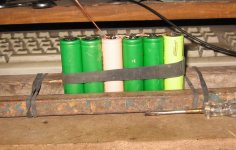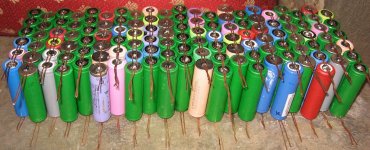numberonebikeslover
1 kW
Big question;
Does internal resistance (IR) of LiCo cell increases with descending health?
I met one of the mechanic who is repairing laptop batteries. He is of the view that with descending health the internal resistance increases. He had a machine with two digital displays. One showing voltage while other showing IR. He says that the new cells have 40 ohms while the ones that we take out from discarded batteries have about 60 to 80 ohms. At 80 ohms they are worthless for laptops.
Finally found time and checked the battery. To my complete surprise the battery was way down (70 volt). checked the individual 6ps and found that two of them were showing zero voltage. Took them apart and found that one of the copper plat shorted the positive of plat with the body and destroyed all the 6 cells in a parallel. Oh God! after going through a lot of brain storming I think that soldering a good size fat wire would be more firm reliable.
Charged the individual cells to 4.2 and left them over night and found that I have lost 43 cells in the accident. That is quite a big loss for me. But I have not lost hope and have learned an expensive lesson. It is just that I got so busy with my office and were not able to even look at my bike. I love my e-bike work but to making a living is something that I can't get away with. So little time and so many things to do. Oh God help me.
Naeem
Does internal resistance (IR) of LiCo cell increases with descending health?
I met one of the mechanic who is repairing laptop batteries. He is of the view that with descending health the internal resistance increases. He had a machine with two digital displays. One showing voltage while other showing IR. He says that the new cells have 40 ohms while the ones that we take out from discarded batteries have about 60 to 80 ohms. At 80 ohms they are worthless for laptops.
Finally found time and checked the battery. To my complete surprise the battery was way down (70 volt). checked the individual 6ps and found that two of them were showing zero voltage. Took them apart and found that one of the copper plat shorted the positive of plat with the body and destroyed all the 6 cells in a parallel. Oh God! after going through a lot of brain storming I think that soldering a good size fat wire would be more firm reliable.
Charged the individual cells to 4.2 and left them over night and found that I have lost 43 cells in the accident. That is quite a big loss for me. But I have not lost hope and have learned an expensive lesson. It is just that I got so busy with my office and were not able to even look at my bike. I love my e-bike work but to making a living is something that I can't get away with. So little time and so many things to do. Oh God help me.
Naeem










